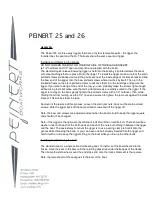
Page 5
Picture of silicone
placement
Fig 2.B
Picture of mounted cross
bar
Fig 2.C
2.0 – Hull Assembly
After unpacking the hulls, verifying the contents and verifying they did not receive any
damage in transport, find a flat soft area to begin the assembly of your boat. Place the
hulls on carpet, foam blocks, or other smooth item where they can be moved without
damaging the surface. First check the width spacing while trying to keep them as close
to the same fore and aft setting as possible. The centerline width of the hulls should be
7’. Check at the bow and stern. Once this is set, measure the diagonals of the hulls to
make sure they are not skewed. This should be within 1/8” of each other. Adjust the
fore and aft position of the hulls as required, and recheck the width measurement to
ensure it has not changed. This may take several iterations. It is very important that
this be done very carefully as severe damage could occur to the beams or hulls if they
are tightened with the hulls out of alignment. (Figure 2.A).
Once the hulls are set, remove the bolts from the cross bars and set on the hulls. Dry
fit the bolts to ensure everything will fit smoothly. The hulls were pre-assembled in the
factory, so if they are aligned properly, the bolts should slide smoothly into the hulls.
After you are confident of the fit, lift the beams and place a bead of silicone around the
bolt holes and another small amount around the perimeter of the beam landings. This
will seal the holes to help prevent minor leaking of the boat. Now install the bolts and
tighten to 18 to 20 ft/lbs with a torque wrench, always making sure the hulls have not
shifted. Note these bolts need to be kept tight. Always check them before sailing the
boat. They will need tightening the first few times the boat is sailed. They should settle
in after a few sails.
Warning: Diagonal measurements need to be within 1/8” of each other or
damage to the beams and/or hulls could occur.
Warning
Picture of Hulls on blocks showing
dimensions
Figure 2.A



































